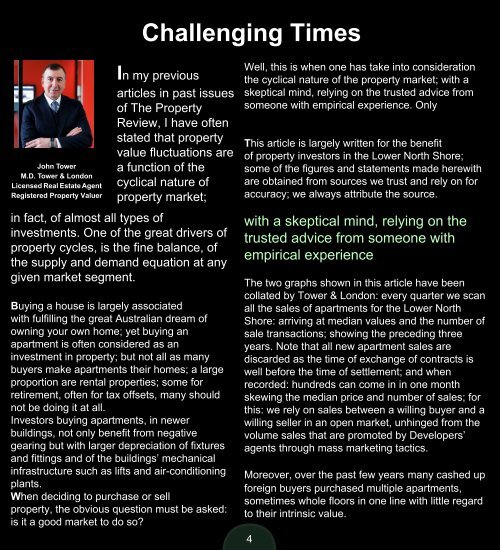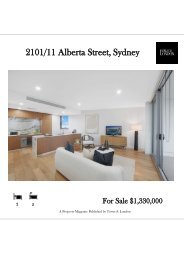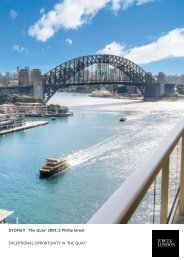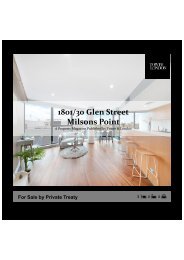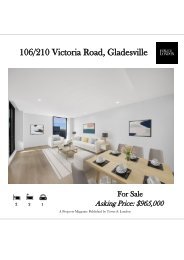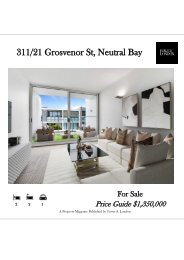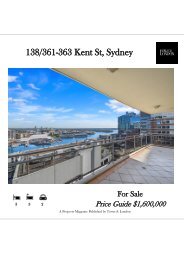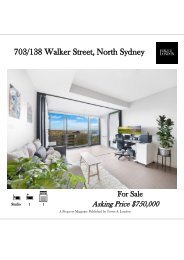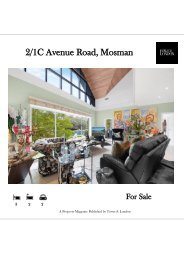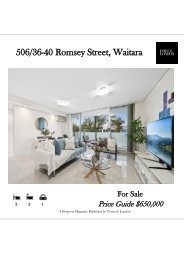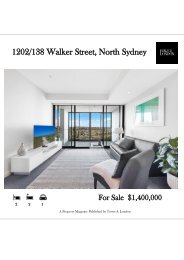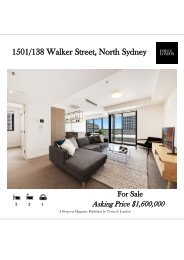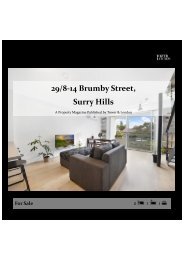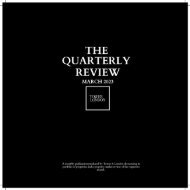Tower&London_PropertyReview_Preview 2016 Winter
Create successful ePaper yourself
Turn your PDF publications into a flip-book with our unique Google optimized e-Paper software.
John Tower<br />
M.D. Tower & <strong>London</strong><br />
Licensed Real Estate Agent<br />
Registered Property Valuer<br />
Challenging Times<br />
In my previous<br />
articles in past issues<br />
of The Property<br />
Review, I have often<br />
stated that property<br />
value fluctuations are<br />
a function of the<br />
cyclical nature of<br />
property market;<br />
in fact, of almost all types of<br />
investments. One of the great drivers of<br />
property cycles, is the fine balance, of<br />
the supply and demand equation at any<br />
given market segment.<br />
Buying a house is largely associated<br />
with fulfilling the great Australian dream of<br />
owning your own home; yet buying an<br />
apartment is often considered as an<br />
investment in property; but not all as many<br />
buyers make apartments their homes; a large<br />
proportion are rental properties; some for<br />
retirement, often for tax offsets, many should<br />
not be doing it at all.<br />
Investors buying apartments, in newer<br />
buildings, not only benefit from negative<br />
gearing but with larger depreciation of fixtures<br />
and fittings and of the buildings’ mechanical<br />
infrastructure such as lifts and air-conditioning<br />
plants.<br />
When deciding to purchase or sell<br />
property, the obvious question must be asked:<br />
is it a good market to do so?<br />
Well, this is when one has take into consideration<br />
the cyclical nature of the property market; with a<br />
skeptical mind, relying on the trusted advice from<br />
someone with empirical experience. Only<br />
<br />
<br />
This article is largely written for the benefit<br />
of property investors in the Lower North Shore;<br />
some of the figures and statements made herewith<br />
are obtained from sources we trust and rely on for<br />
accuracy; we always attribute the source.<br />
with a skeptical mind, relying on the<br />
trusted advice from someone with<br />
empirical experience<br />
The two graphs shown in this article have been<br />
collated by Tower & <strong>London</strong>: every quarter we scan<br />
all the sales of apartments for the Lower North<br />
Shore: arriving at median values and the number of<br />
sale transactions; showing the preceding three<br />
years. Note that all new apartment sales are<br />
discarded as the time of exchange of contracts is<br />
well before the time of settlement; and when<br />
recorded: hundreds can come in in one month<br />
skewing the median price and number of sales; for<br />
this: we rely on sales between a willing buyer and a<br />
willing seller in an open market, unhinged from the<br />
volume sales that are promoted by Developers’<br />
agents through mass marketing tactics.<br />
Moreover, over the past few years many cashed up<br />
foreign buyers purchased multiple apartments,<br />
sometimes whole floors in one line with little regard<br />
to their intrinsic value.<br />
Sydney Unit Market<br />
Everyone knows there are currently<br />
many more residential apartment buildings<br />
under construction than usual: Saturday’s SMH<br />
Domain is dominated by advertisements of new<br />
developments, from Liverpool to Penrith,<br />
Hornsby down to Hurstville and of course the<br />
prime areas of the North Shore and Eastern<br />
Suburbs.<br />
Most, in my view, are asking higher prices than<br />
intrinsic values; too much for the internal size of<br />
the apartments offered. A two bedroom unit<br />
used to be about 100 square meters, now some<br />
are just 65 square meters, with a price tag of<br />
about $15,000 per square meter, and more in<br />
prime areas.<br />
They may be able keep them there<br />
of a couple of years, but eventually<br />
costs will catch up and Owners’<br />
Corporations will be forced to<br />
drastically increase levies<br />
The other intriguing development is the<br />
advertised “estimated Strata Levies” often well<br />
below realistic levels, they may be able keep<br />
them there of a couple of years, but eventually<br />
costs will catch up and Owners’ Corporations<br />
will be forced to drastically increase levies,<br />
particularly when these buildings are frequently<br />
marketed as resort-like with swimming pools,<br />
gyms, rooftop lounges; and the most expensive<br />
of all: 24 hour concierge.<br />
4 5<br />
According to the property website,<br />
onthehoue.com.au/market analysis: median<br />
value for apartments in Sydney has increased<br />
by 1.8% in the June quarter <strong>2016</strong>; and 6.4%<br />
for the past 12 months to $704,000.<br />
Rents are a good signal of<br />
change in the swing of supply and<br />
demand<br />
Median rents have remained the same for the<br />
past year at $550 per week. Rents are a good<br />
signal of change in the swing of supply and<br />
demand: it is interesting that for many years<br />
rents have been increasing, yet, they are now<br />
static. This is because of the massive supply of<br />
apartments bought by investors overwhelming<br />
the rental market, diminishing returns.


